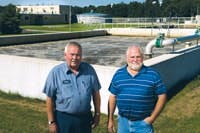Nestled in the heart of the state along the Wisconsin River, the city of Wisconsin Rapids, Wis., spans 14 sq miles and is home to about 18,000 people. The area prides itself on grandiose holiday celebrations and a growing business community, rooted strongly in coated paper, vegetable farms and cranberry products.
The Wisconsin Rapids Wastewater Treatment Plant (WWTP), which also serves the neighboring village of Biron and various local septage haulers, was constructed in 1969. It was built to handle 4 million gal per day (mgd), including 4,500 lb bio- chemical oxygen demand (BOD) and 5,400 lb total suspended solids (TSS). In 1993, the city completed a major upgrade that brought the WWTP to a 5.16-mgd capacity, with the ability to treat 8,900 lb BOD and 9,300 lb TSS daily.
Industrial Influx
In the fall of 2005, Ocean Spray Cranberries—an industrial customer in Wisconsin Rapids’ sewer service area—expanded its production facilities, sending additional flows and twice as many loadings to the WWTP. Another local cranberry processor, Mariani Packing Co. (then Urban Processing), also recently had requested increased flow and load capacity. The WWTP was a few years shy of any standard upgrades, but Wisconsin Rapids decided it was best to address any facility deficiencies immediately to accommodate local industrial needs.
The city consulted with the two cranberry companies as well as other industries in the sewer service area to determine their future business plans and wastewater treatment needs, and to discuss the costs that would be incurred for WWTP expansion. Plans to upgrade the WWTP commenced in 2006. Project design got underway in 2007, and the first phase of construction began in the fall of 2008.
The final treatment process went online in the spring of 2011, and today the newly updated plant is capable of managing 5.27 million gal of wastewater, 17,800 lb BOD and 10,000 lb TSS on a daily basis.
WWTP Upgrades
Primary treatment. The heating and ventilation system at the headworks was updated, and grit and screenings washers were installed. Clog-prone sludge and scum pumps located more than 200 ft from the primary clarifiers were removed. A building housing new pumps—diaphragm, progressive cavity scum and sludge—was constructed next to the primary clarifiers for improved efficiency.
Primary clarifiers. Ultrasonic sludge blanket indicators were installed.
Moving-bed bioreactors (MBBRs). Deemed capable of treating heavy loading with a small footprint, two 182,400-gal coarse-bubble MBBRs were added.
Blowers. Another building houses three new high-speed, high-efficiency turbo compressors, which replaced positive-displacement blowers. Dissolved oxygen sensors control their speed. The blowers building also contains a new diesel emergency generator that can supply the WWTP’s power needs in case of an electrical outage. Final clarifiers. A new 100-ft-diameter final clarifier was installed to replace three existing clarifiers that the facility had outgrown. The clarifier’s peripheral baffles provide improved hydraulics.
Liquid sludge storage tank. An existing liquid sludge storage tank was converted to include a new waste activated sludge (WAS) tank and four new digester feed tanks. Extra tank storage is available for sludge hauled in from other facilities; haulers must use a card reader, generating automatic billing.
Sludge thickening. Two rotary drum thickeners were installed to thicken WAS, and two rotary sludge presses were installed to produce cakes. Air is drawn off by positive-displacement blowers and used to aerate the WAS tank.
Anaerobic digestion. Two existing anaerobic digesters are operated at thermophilic temperature (131 ̊F), and a new secondary digester is operated at mesophilic temperature (95 ̊F). In addition to producing Class A sludge, this combination improves digestion and maximizes biogas production.
Solids building. The WWTP added an engine/ generator that can run on biogas, natural gas or a blend thereof. The unit can produce up to 335 kW of electricity and recover up to 1.3 million BTU of hot water per hour. It typically supplies about half of the facility’s electrical and heating needs.
Sludge drying. Trucks transport sludge cakes to a nearby city storage site, where they are dried on a four-acre asphalt pad. A loader pulls a sludge turner that periodically flips the cakes. The process increases the solids content of the cakes from 16% to 18% delivered to 60% to 70% post-drying, while decreasing their weight sevenfold.
Sludge disposal. With its Class A rating, the sludge can be used by the city and other end-users for landscaping, topsoil amendment or as an agricultural soil conditioner.
SCADA. The entire SCADA system was updated.
Money Matters
The upgrade project carried a final price tag of $28.3 million. The Economic Development Administration provided a $1.5-million grant, and Focus on Energy provided a grant for $189,000. A Wisconsin Clean Water Fund loan (20 years at a rate of 3.4%) covered the rest of the project cost. Ultimately, the WWTP’s industrial users will cover 49.2% of the total cost and residential customers will pay the remaining 50.8%.
“We have one of the most updated and techno- logically advanced plants in the area that has been built to expand easily for economic development,” said Jim Neitzel, wastewater construction supervisor. He credited the staff of the Wisconsin Rapids WWTP for running the project smoothly.
Download: Here


